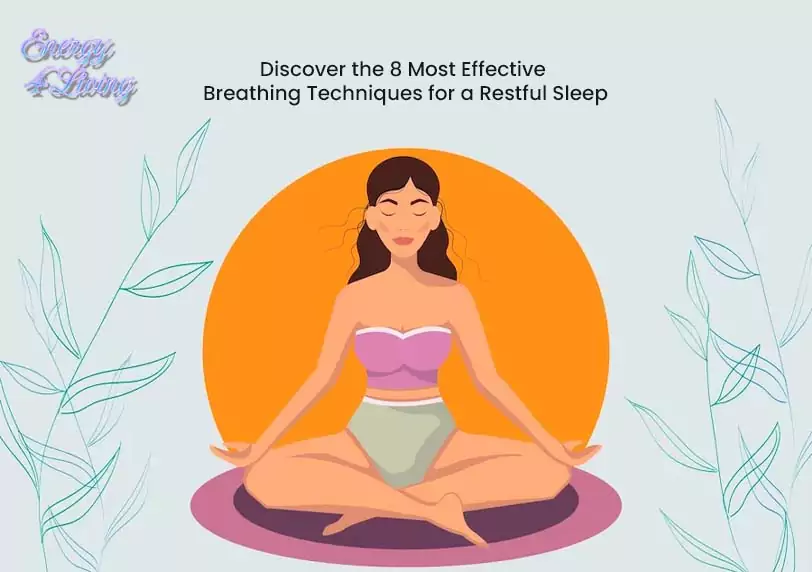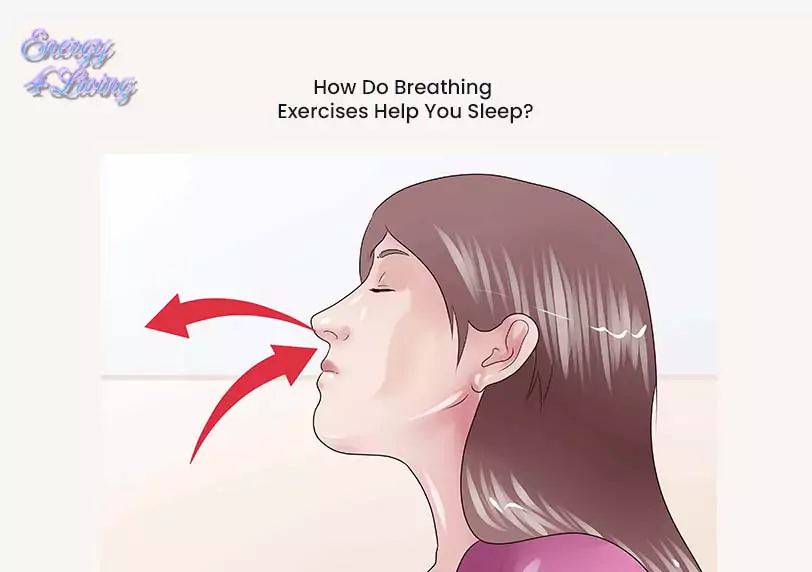Are you having trouble falling asleep at night and finding it hard to calm your mind? If so, you are not alone. Many people experience sleep-related issues, from difficulty falling asleep to waking up feeling unrested. Incorporating breathing exercises into your sleep routine can help you relax and improve the quality of your sleep. This comprehensive guide will explore seven practical breathing exercises for sleeping and recommend ways to incorporate them into your daily routine.
Key Takeaways
- Breathing techniques like diaphragmatic breathing and the 4-7-8 method can help you relax and sleep better.
- Box and alternate nostril breathing ease anxiety and promote mental calmness, facilitating sleep.
- Techniques like progressive muscle relaxation and resonant breathing can help relieve physical tension and promote a calm, sleep-promoting state.
- Before going to bed, try guided visualisation with breath. This technique combines mental images and breathing techniques to encourage relaxation and lower tension.
- Including breathing techniques in your bedtime ritual can help establish a peaceful, tranquil space ideal for sound sleep.
Discover the 8 Most Effective Breathing Techniques for a Restful Sleep

We have compiled a list of 7 effective breathing exercises to help you sleep better and combat nighttime restlessness.
1- The 4-7-8 method
This breathing method, made famous by Dr. Andrew Weil, may be straightforward yet powerful for promoting calm and igniting sleep. To practice it, take deep breaths through your nose for four counts, hold them for seven counts, and then slowly exhale through your mouth for eight counts. Repeat this cycle many times, allowing yourself to relax and focus on your breath’s rhythm.
2- Diaphragmatic Breathing
Diaphragmatic or stomach breathing involves locking the stomach shut so that deep, moderate breaths are needed. To practice diaphragmatic breathing, you can place one hand on your abdomen and the other on your chest. Take deep breaths through your nose, allowing your stomach to rise while you fill your lungs with conversation. Feel your belly descend as you exhale while slowly releasing the air through your lips. By repeating this process for several minutes, you can focus on how your breath enters and exits your body, which is a great way to help reduce stress and improve your overall well-being.
3- Alternate Nostril Breathing (Nadi Shodhana)
“Nadi Shodhana,” or “the exchange of nostril breathing,” this yoga breathing technique may alter the body’s energy pathways and induce mental calmness. Sit comfortably with your eyes closed and your spine straight to perform this technique. Put your right thumb over your right nostril and take a deep breath in through the nostril that has been cleaned. At that point, exhale slowly through your right nostril near your cleared-out nostril along with your ring finger. Breathe through your right nostril, near it, and breathe through your cleared-out nostril with your thumb. Proceed to substitute nostrils for a few minutes, centring on the tender beat of your breath.
4- Box Breathing
Box or square breathing is a specific method for reducing stress and advancing relaxation. To practice box breathing, take four deep breaths via your nose, hold them for four counts, slowly exhale through your mouth for four counts, and finally, hold your breath for another four counts. Repeat these steps several times, focusing on the shape of a square each time you inhale and exhale.
5- Resonant Breathing
Resonant or coherent breathing involves breathing firmly to synchronise heart rate inconstancy and advance relaxation. To practice resounding breathing, breathe in gradually and profoundly through your nose for six counts, then breathe out gradually and totally through your nose for six counts. Proceed with this technique for a few minutes, centring on the sensation of your breath and permitting your body to unwind.
6- Progressive Muscle Relaxation with Breath
Dynamic muscle relaxation is a technique that involves tensing and then relaxing specific muscle groups in the body to promote relaxation. To incorporate breath into this practice, one can inhale deeply as they tense a particular muscle, such as the shoulders or hands, and then exhale slowly and completely as they release the tension in that muscle group. One can continue to go through different muscle groups in the body, inhaling as they tense and exhaling as they relax until they experience a profound sense of relaxation.
7- Guided Visualization with Breath
Guided visualisation is a technique that combines breathing exercises with mental symbolism to promote relaxation and decrease stress. To practice guided visualisation with breath, start by closing your eyes and taking a few deep breaths to relax your body and calm your mind. Then, imagine yourself in a tranquil setting, such as a serene shoreline or a lush forest. As you breathe deeply, visualise yourself soaking up the peaceful environment’s sights, sounds, and sensations, allowing you to release any tension or stress you may be feeling. This technique can be a helpful tool to help you unwind and find a sense of calm in your daily life.
8- Ocean Breath Meditation
The Ocean Breath Meditation, inspired by the rhythmic sound of ocean waves, is a soothing technique to lull you into a deep sleep. Begin by finding a comfortable position, either sitting or lying down, and close your eyes. Take a few moments to settle into your breath, allowing it to become steady and natural. Now, imagine yourself standing on a peaceful beach, with the gentle sound of waves crashing against the shore. As you inhale deeply through your nose, envision the waves rolling in, filling your lungs with calm, rejuvenating energy. Then, as you exhale slowly through your mouth, visualize the waves receding back into the ocean, carrying away any tension or worries with them. Continue this rhythmic breathing pattern, syncing your inhales and exhales with the ebb and flow of the imaginary waves. Let the soothing sound of the ocean guide you into a state of deep relaxation, allowing you to drift off into a peaceful slumber.
How Do Breathing Exercises Help You Sleep?

Breathing exercises for sleeping help promote relaxation, reduce stress levels, and calm the mind and body. Let’s delve into how these exercises achieve these benefits.
1- Turning On the Relaxation Response
Breathing exercises activate the relaxation response within the body, which is the usual inverse of the stress-induced “fight or flight” reaction. You can balance stress and advance relaxation by enacting the parasympathetic apprehensive exercise through unfaltering, profound breathing.
2- Decrease Stress-Related Hormones
Breathing profoundly and routinely signals your body to unwind. This reduces the union of stress chemicals like cortisol and adrenaline, which can disturb sleep and increase pressure and uneasiness.
3- Decreasing Muscle Pressure
Breathing exercises, mainly when dynamic muscle relaxation is performed, assist in discharging pressure from the body. As you breathe in profoundly and gradually breathe out, you deliberately unwind distinctive muscle bunches, permitting them to let go of snugness and stiffness. This physical relaxation contributes to a sense of general calmness and status for sleep.
4- Calming the Intellect
One key advantage of breathing is its capacity to calm the intellect and calm hustling meditations. By centring on the rhythm of your breath, you move your centre absent from stresses and diversions, making a difference. You let go of mental chatter and prepare for sleep.
5- Enhancing Mindfulness and Awareness
Breathing exercises for sleeping promote mindfulness and present-moment awareness, permitting you to observe your thoughts, feelings, and sensations without judgment. This non-reactive state of mind helps you develop inward peace and acknowledgement, making it less demanding to discharge stresses that will keep you awake.
6- Regulating the Autonomic Nervous System
Breathing exercises out and offers assistance in controlling the autonomic nervous system exercise, which controls substantial capacities such as heart rate, blood pressure, and absorption. By exercising moderate, profound breathing, you’ll impact the adjustment between the thoughtful, anxious frame exercise (mindful of the stretch reaction) and the parasympathetic apprehensive frame exercise (dependable for relaxation), advancing a state of calmness and status for sleep.
Energy4Living For Good Sleep
Energy4Living’s Energy Alchemist App provides a holistic approach to wellness, focusing on better sleep and increased energy for a fulfilling life. By emphasizing the importance of good sleep as the foundation of well-being, the app offers techniques and meditations specifically designed to promote restful sleep and revitalize energy levels in just seven days. Moreover, the app includes stress-relieving methods to reduce tension and promote relaxation, contributing to a happier and more balanced lifestyle. With resources for meditations, the app helps individuals find inner peace and rejuvenation, making it particularly beneficial for beginners exploring holistic healing. Overall, Stacy Gleich’s Energy Alchemist App empowers users to take control of their health and vitality through effective sleep techniques and energy-enhancing practices.
FAQs:
Yes, insomniacs may benefit from breathing exercises. They help people relax and reduce tension, which makes it easier to fall asleep and stay asleep throughout the night.
To benefit from relaxation and improve the quality of your sleep, it is recommended that you do breathing exercises for five to ten minutes before going to bed.
Although breathing exercises alone may not cure sleep apnea, they can help those with the disorder by encouraging relaxation and enhancing respiratory function. These exercises include breathing through both nostrils alternately and diaphragmatically.
Yes, breathing exercises and other relaxation methods, such as progressive muscle relaxation, guided imagery, and meditation, may increase efficacy and encourage deeper sleep before bed.
Conclusion
Incorporating breathing exercises into your sleeping routine can be a powerful way to promote relaxation, reduce stress, and improve the quality of your sleep. There are many different breathing exercises, such as the 4-7-8 technique, diaphragmatic breathing, or alternate nostril breathing. Experimenting with different breathing exercises can help you discover the best ones. Making breathing exercises a regular part of your daily routine can help create a calm and peaceful environment that promotes restful sleep. So why not try these breathing exercises today and experience the transformative power of relaxation?
